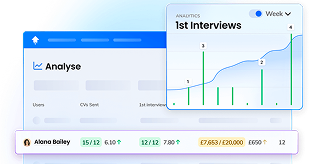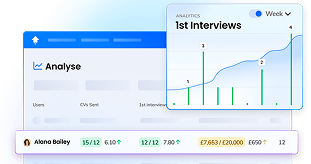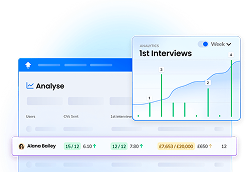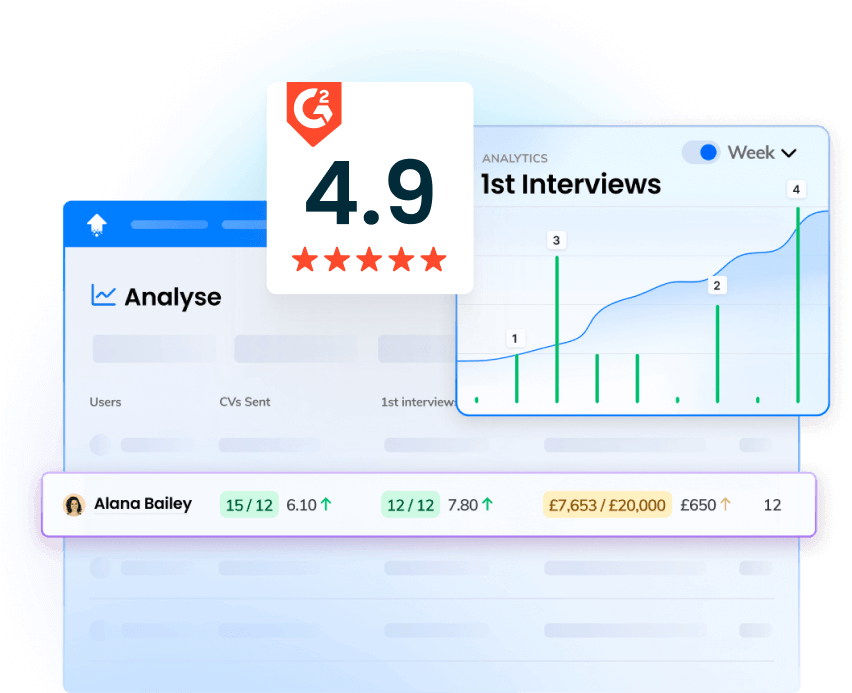Stages of the Recruitment Funnel
The recruitment funnel encompasses five key stages:
- Awareness
- Interest
- Application
- Selection
- Hiring
Here’s what you need to be aware of when building your recruiting funnel template.
Awareness: Attracting Talent
Sitting right at the top of the recruitment funnel, this is the phase in which potential candidates first become aware of your agency and its open positions.
The more people that are aware of your agency, the wider your talent pool.
But don’t just sit back and hope potential candidates stumble upon your agency by chance.
Instead, boost the awareness phase by taking action to attract talent.
Here are a number of strategies to help you grab attention.
- Create written, graphical and video content for your website and social media channels that puts your agency brand front and centre and answers frequently asked questions.
- Build your personal brand and position yourself as a thought leader on LinkedIn by frequently posting useful and entertaining insights for job seekers.
- Engage with potential candidates and target candidates on social media by joining conversations and being active in the comments of your own posts. Then encourage direct messages when you encounter an interested job seeker.
- Use both paid and organic job adverts on search and social media to attract professionals in the relevant sector.
- Post every new job description on jobs boards that specialise in the relevant sector.
- Engage with passive candidates at events and on social media to continue building your future talent pipeline.
- Use social media to direct potential candidates to your website where they will find much more information about your employer brand and vacancies.
- Develop optimised landing pages for each sector you hire into that will bring visitors in from Google searches.
Interest: Engaging Potential Candidates
So now the job seeker is aware your agency exists, you need to pique their interest and encourage them to learn more.
This is where nurturing comes in.
At this point, the potential candidate should be actively researching your agency — and you need to ensure the information they’re looking for is super easy to find and personalised to them.
If they take a look at your website and decide your agency isn’t what they’re looking for — or they simply don’t like the vibe — they’ll drop out of the funnel without a backwards look.
To keep talent sliding down the funnel, use data surrounding their previous job searches to deliver:
- Personalised content
- Personalised job opportunities
- Personalised event marketing
- Custom calls to action
For example, if a candidate arrived at your site by Googling “tech sales jobs,” you want to put tech sales jobs in front of them.
This can be achieved on your website (think ‘you may also be interested in’ tabs when shopping online), or by automated newsletter if you have permission to send them emails.
You can also assign them a recruiter who will send them any new tech sales jobs that come up via email, text, or LinkedIn, as well as content about the tech or sales industries and relevant events.
This will make the potential candidate feel like you’re exactly the right agency to help them get where they want to be.
If, however, they arrive at your website and are met with content about ecommerce marketing, they’re likely to decide you’re not the agency for them.
Having a strong bank of easily accessible FAQs on your website is particularly important at this stage of the funnel as candidates are deciding whether to reach out to you or not.
Remember: make sure your agency’s branding and digital footprint is cohesive across all channels.
The interest stage is all about building trust in your agency, and an outdated website that has a different look and feel to your slick social media branding can be hugely off-putting.
Application: The Submission Process
Well done!
You’ve masterfully transported your candidate through the awareness and interest stage — and now they’ve decided to apply.
But this is no time to sit back and relax.
Many candidates drop out during the application phase.
You need to keep these candidates engaged by ensuring the application stage is as quick, easy, and smooth as possible.
Who among us hasn’t quit an application form half way through — despite previously being excited about the role — because it was way too long and arduous to fill in?
Indeed, research shows that some 60% of job seekers give up in the middle of filling out application forms online.
Why?
The processes were too lengthy or complex.
So, how do we optimise the application process to increase conversions?
Firstly, keep application forms simple.
Of course, you need enough information to thoroughly screen candidates, but don’t make them repeat everything that’s on their CV, or write huge personal essays.
Instead, focus on the most important questions, while reducing the overall size of the application.
Ensure the website or app that hosts the application process is up to scratch.
This is an important one in 2024.
There’s nothing like a long-buffering or improperly loading web page to dent trust in a brand.
And, with candidates increasingly using mobile devices to apply for roles, it's vital to ensure the application process is optimised for mobile too.
Communicate frequently throughout the application process, using automation to save your recruiters time.
Welcome them to the application process via an email that delivers everything they need to know about it.
Automate follow-up emails that remind applicants to complete the application form where they have left it half-finished.
These points of contact may seem small, but they help candidates to remain engaged with the process.
Want to know what the applicant journey is like?
Complete the application yourself, and identify and resolve any points of friction along the way.
Remember — throughout the application process, you need to be collecting valuable candidate data.
In addition to indicating whether the candidate is right for the role they are applying for, this should give you key insights into your sourcing channels, talent pool, and recruitment processes.
Drawing insights from this data then empowers you to adapt and improve the process for future applicants.
Selection: Screening and Interviews
The screening and interview stage is one of the most critical to ensure you deliver a quality hire.
During this phase, you’re seeking candidates with the right qualifications, skills and experience for the role, while eliminating those who are not a good fit.
You also want to go a bit deeper, learning more about candidates’ personalities and considering how they will fit within the company’s culture.
Throughout this phase, recruiters need to be in constant contact with candidates, letting them know exactly what to expect and when, scheduling evaluations and interviews, and feeding back.
Best practices for screening candidates range from the traditional to the modern.
They include:
- Reviewing CVs and cover letters
- Phone screening
- Video screening
- One-way video interviews
- In person interviews
- Group interviews
- Social media searches
- Contacting references
- Job knowledge assessments
- Hard and soft skills evaluations
After your candidates are screened, it’s time for interviews.
This may involve one or more rounds of interviews with a recruiter, hiring manager, wider hiring team, future colleagues and/or senior leadership.
Here, recruiters must set their interviewees up for success by thoroughly preparing them for the interview, from what to expect on the day to what they should research ahead of the big day.
Following the interview, give feedback as quickly as possible to ensure you’re not giving applicants false hope — and to keep the successful candidate engaged with the process.
Hiring: Making the Offer
This is the best part of any recruiter’s job.
You’ve found an exciting candidate, the client is thrilled, and soon you’ll collect your commission.
What’s more, you get to deliver the happy news with a formal job offer.
But the final stage of the recruitment funnel can be more challenging than it initially sounds.
From salary and benefits to start date, there’s often plenty to negotiate at this stage — and if discussions fall through, you can lose your winning candidate at the final hurdle.
So how can you help to ensure your candidate accepts your offer, and not one from another company?
This process starts higher up the funnel in the screening stage, when you’re getting to know your candidate.
At this point you should have asked about their motivations, goals, and how they would like their future career to look, as well as any expectations surrounding salary and benefits.
You also need to make sure the candidates understand what the company is offering — and that the compensation and benefits package aligns with the candidate’s expectations.
It’s also important to highlight opportunities for growth and progression with their new employer at this point, in addition to any training, opportunities or mentorship schemes on offer.























